Mastering the Craft of Hand Stitching Leather Shoes
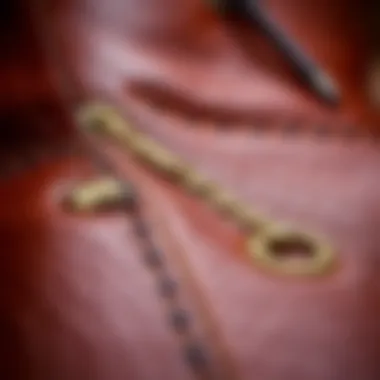
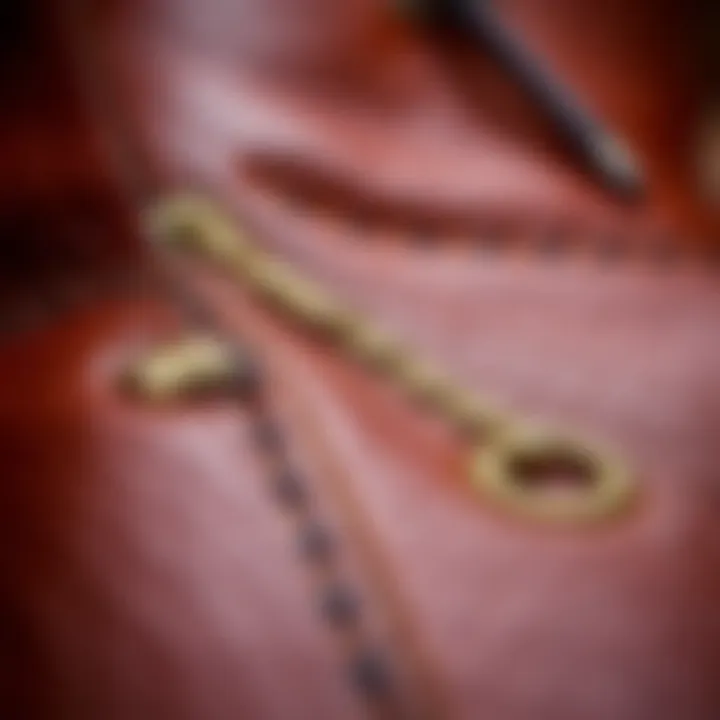
Intro
Hand stitching leather shoes is more than just a method; it’s a time-honored craft that has been passed down through generations. For those who appreciate the beauty and serviceability of handcrafted footwear, understanding the nuances of this art is essential. The techniques involved in hand stitching can breathe life into a simple design, transforming it into a functional piece of art.
This guide delves into the historical significance, technical requirements, and aesthetic value of this craft. It aims to elevate your understanding whether you’re a wannabe shoemaker testing the waters or a seasoned artisan looking to refine your skills.
Through our exploration, we will shed light on the materials that contribute to the unrivaled quality of hand-stitched shoes, alongside offering insightful tips for selecting the right leather. Focusing on details might seem tedious at times, but in craftsmanship, every little bit counts. A sturdy thread, an accurate stitch length, and the choice of leather can make or break a shoe. In today’s blog, we will not only touch on these crafts but also examine how hand-stitched shoes find their place in modern fashion, cementing their relevance amidst ever-evolving trends.
Brace yourself to step into the meticulous world of shoemaking, where patience meets passion.
Intro to Hand Stitched Leather Shoes
Hand stitching leather shoes is more than just a method of assembly; it's an art form steeped in tradition and precision. This introduction highlights why the craft merits our serious consideration. Hand-stitched shoes embody a level of craftsmanship that machine-made footwear simply cannot replicate. Each stitch carries the individual touch of the maker, showcasing unique techniques and a commitment to quality that resonates with discerning consumers.
The importance of hand-stitched leather shoes extends beyond their aesthetic appeal. They offer durability, often outlasting their factory-made counterparts. With proper care, these shoes can accompany their owners on countless journeys, weathering time and trends alike. Moreover, choosing hand-stitched footwear often reflects personal values, such as sustainability and appreciation for artisanal craft. This approach is in stark contrast to the fast fashion industry, where mass production can compromise quality and environmental considerations.
Historical Perspectives
The story of hand stitching leather shoes can be traced back centuries, woven into the very fabric of human civilization. In ancient times, shoes were crafted as a necessity, with artisans employing rudimentary techniques to protect feet. As cultures evolved, so did shoe-making techniques. Historical records reveal that during the Middle Ages, the art of shoemaking blossomed in Europe, particularly in Italy and England, where cobblers became highly respected members of society.
These artisanal shoemakers relied on their skills to create custom-fit footwear, often working closely with clients to ensure comfort and style. The rise of modernity brought about significant changes in production methods, leading to the widespread adoption of machine-made shoes. Yet, the revival of hand-stitched techniques in the 20th century marked a resurgence of interest in bespoke quality, aligning perfectly with the growing desire for individuality in fashion.
Cultural Significance
Beyond their historical roots, hand-stitched leather shoes carry significant cultural weight. In many societies, handcrafted shoes symbolize craftsmanship and heritage. They often tell a story about the cultural values and lifestyles of the people who wear them. For instance, in certain indigenous cultures, distinct stitching and design motifs reflect traditional beliefs and practices, intertwining fashion and identity.
Furthermore, as a response to global industrialization, the renewed interest in hand-stitched leather shoes aligns with a broader movement toward sustainability and ethical consumption. In an age marked by fast fashion's environmental impact, consumers are increasingly eager to invest in pieces that embody timeless craftsmanship and social responsibility.
Understanding Leather as a Material
When it comes to hand stitching leather shoes, understanding leather as a material isn’t just important; it’s paramount. Leather is more than just a medium for creating footwear; it’s a fabric rich in history, culture, and functionality. Knowing the differences in leather types can dramatically influence the final product's quality and aesthetic appeal. It affects the durability, feel, and overall presence of the shoes, making it a vital consideration for anyone passionate about craftsmanship.
Types of Leather
Leather classification is essential to making informed choices when crafting shoes. Here are the main types you’ll encounter:
Full-grain
Full-grain leather is often regarded as the king of leathers. This type retains its natural grain and texture, allowing for unique character and patina to develop over time. It's thick and durable, making it a favorite among artisans. One key characteristic of full-grain leather is that it hasn’t been sanded or buffed, which can uphold its strength and breathability.
However, while its robust nature offers many advantages – such as resistance to wear and an ability to develop a beautiful aging process – it can be more difficult to work with, especially for novice shoemakers. In sum, choosing full-grain leather bodes well for those aiming for long-lasting and aesthetically pleasing footwear.
Top-grain
Top-grain leather is a step down from full-grain in terms of durability but still stands high on the quality scale. It features a sanded and refinished surface, often boasting a more uniform appearance. The unique aspect of top-grain leather is its softness, which makes it easier to work with and mold around the foot. Because of this, many shoemakers love using it for custom jobs. However, it’s worth noting that by removing the natural grain layer, some breathability and character from the material might be lost.
Top-grain is a good choice for those who prioritize comfort and style over rugged durability, striking a balance in the crafting process while still providing high-quality results.
Genuine leather
Genuine leather is often where confusion sets in because it can mislead potential buyers. It is often seen as the entry point for those new to leather working. It’s made from the leftover layers after higher grades have been processed and tends to be less durable over time. The main advantage is its affordability, appealing to those trying their hand at shoemaking on a budget. However, the drawbacks mean you may not get the longevity or character found in full-grain or top-grain leathers.
The key takeaway is that while genuine leather can make for decent shoes, it’s essential to manage expectations regarding longevity and wear.
Selecting Quality Leather
When selecting quality leather for your hand-stitched shoes, you might consider several factors:
- Source: Where does the leather come from? Understanding the origin can help gauge quality.
- Thickness: Thicker leather often provides more durability, but it can be harder to work with.
- Feel: Quality leather should feel supple and not overly stiff – it can make a world of a difference after being worked into footwear.
In the end, knowledge about these various types of leathers empowers you to make choices that align with the vision you have for your creations.
The Tools of the Trade
In the realm of hand-stitching leather shoes, the tools you wield are akin to a painter’s brush or a sculptor’s chisel. Each tool plays a crucial role in bringing the vision of handcrafted footwear to life. Understanding these instruments not only equips the amateur shoemaker with the necessary skills but also adds depth to the expert artisan’s craft. With the right tools, one can transform raw leather into a polished piece of art. Below, we explore essential sewing tools and cutting instruments that every shoemaker should have in their toolkit.
Essential Sewing Tools
Needles
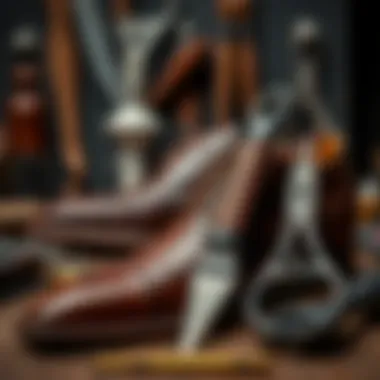
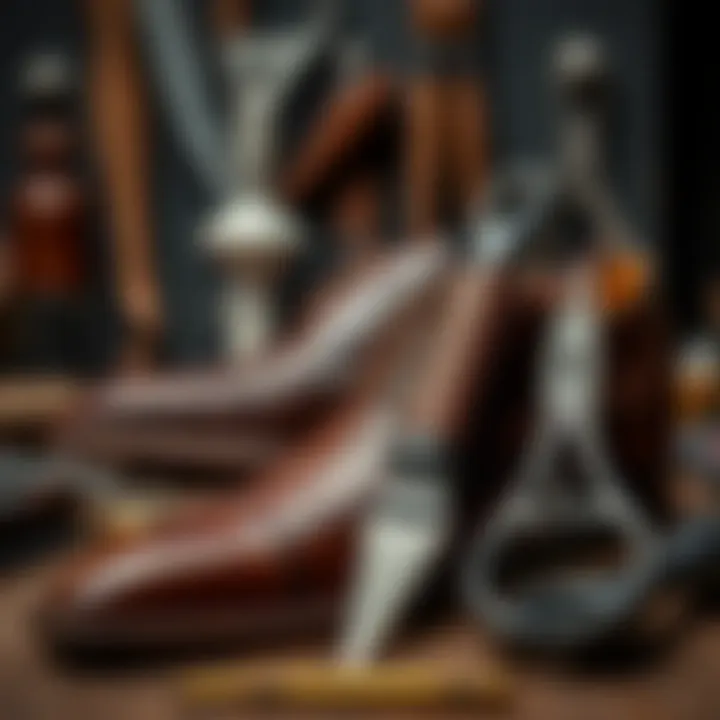
Needles, the unsung heroes of hand stitching, come in various sizes and shapes, tailored for different tasks. For leatherwork, the most commonly used is the leather needle. This type has a triangular point that pierces the tough fibers of leather with ease. The key characteristic of a leather needle lies in its ability to create a clean hole, reducing damage to the material while ensuring a sturdy stitch. This is critical when crafting shoes, where durability can't be compromised.
A beneficial aspect of using leather needles is their design, which prevents the frustration of splitting the leather strands during work. However, they can be a bit pricier than standard sewing needles. Additionally, understanding when to switch out needles, especially if they dull, can make a significant difference in your final outcome.
Thread
The thread is the lifeblood of hand-stitched leather shoes. A strong, durable thread is essential to withstand wear and tear. Waxed thread is often the go-to choice because it grips the leather fibers well, providing a secure hold and a clean finish. The primary characteristic of waxed thread is its resistance to fraying and breaking, especially during varied weather conditions, an important consideration while walking outdoors.
A unique feature of waxed thread is its ability to glide through leather easily, which aids in achieving even tension throughout the stitching process. That said, the thickness of the thread can impact the aesthetics of your shoes; thicker threads often lend a rugged look, while thinner threads yield a more refined appearance. Shoemakers must carefully select the thread that matches their design vision.
Awls
Awls serve as precision instruments that help in marking holes and guiding threads during stitching. They are vital in ensuring that stitches are evenly spaced and properly aligned, which is critical for both functionality and visual appeal. The key characteristic of an awl is its pointed tip, which makes it simple to create pilot holes for needles, ensuring the leather does not tear.
One of the unique benefits of awls is their versatility; they can be used for various tasks including establishing stitch lines or making alignment adjustments. Some may argue, however, that beginner shoemakers might find it slightly challenging to master the awl’s handling. Practice is invaluable here, as becoming proficient with an awl can significantly enhance the quality of the finished product.
Cutting and Shaping Instruments
Knives
Knives used in leather crafting, particularly those like the utility knife or round knife, are essential for creating clean cuts. A well-honed knife can easily slice through leather, providing precision that scissors may lack. Sharp knives allow the crafter to achieve intricate designs and ensure that each piece fits perfectly during assembly. The benefit of using knives extends to their ability to create clean edges, which contributes to a professional aesthetic.
However, novice users must exercise care, as the risk of injury is higher with knives than with other tools. There’s a learning curve, but once mastered, they can be the most satisfying tools to use.
Scissors
While scissors may seem like an obvious choice for cutting leather, not all scissors are created equal. Specialized leather scissors are designed with ergonomics in mind. They typically feature a shape that allows for a smoother cutting action without excessive strain on the hands. Importantly, these scissors can make clean cuts, which is vital for aesthetics in shoemaking.
One downside is that high-quality scissors can be quite expensive. Additionally, they may dull faster than knives, necessitating consistent maintenance to ensure they cut cleanly.
Templates
Templates are invaluable when it comes to ensuring uniformity across shoe components. Using templates can streamline the cutting process, helping shoemakers maintain consistency in size and shape across multiple pairs. A notable trait of templates is their ability to save time; crafters can trace around them to create precise outlines quickly. They can be made from materials like cardboard or plastic, each with their benefits depending on the project scale.
However, over-reliance on templates can stifle creativity. Shoemakers ought to strike a balance between template use and freehand cutting to preserve the uniqueness of each piece they create.
Ultimately, the tools of the trade in hand-stitching leather shoes provide essential support in turning a vision into a tangible product, combining functionality and art. Getting familiar with these tools can empower both beginners and veteran shoemakers alike to hone their craft with confidence.
Basic Techniques in Hand Stitching
Hand stitching leather shoes is not just about sewing two pieces of material together. It's an art form that requires a keen understanding of various techniques that have developed over centuries. Mastering these fundamental skills is crucial for anyone involved in the crafting of leather shoes, whether they're a professional shoemaker or a hobbyist. These techniques not only influence the overall appearance of the finished product but also its durability and comfort. When you invest the time to learn the basic methods, you're laying a solid foundation for more advanced techniques down the road.
The significance of understanding basic techniques cannot be overstated. First off, incorporating proper methods like the saddle stitch or backstitch ensures consistent tension and reinforces the structure of the shoe. This prevents premature wear and tear, extending the life of the footwear. Moreover, these basic techniques allow artisans to express their individual artistry through subtle variations and adaptations.
Mastering these skills is a transformative experience. They enhance one’s appreciation for the craftsmanship involved in shoemaking. It’s about connecting with the material, understanding its behavior, and knowing how to modify your technique based on the specific leather type, thickness, and desired result. As one person puts it,
"Every stitch tells a story. The way you stitch reveals not just your style but an understanding of the leather that shapes your work."
The Saddle Stitch
The saddle stitch is one of the most revered techniques in hand stitching leather. Originating from traditional craftsmanship, it is lauded for its simplicity as well as its effectiveness. This double-thread method involves passing two needles through the same hole from opposite directions. The result? A strong, durable seam that holds together under stress.
When executed correctly, the saddle stitch creates a distinctive, visually appealing pattern on the outside of the shoe. This method is not only efficient in terms of strength but also offers flexibility. It distributes tension evenly across the stitch line, making this technique ideal for areas that require robust reinforcement, such as along the shoe upper or sole.
In addition to its functional benefits, mastering the saddle stitch lets artisans showcase their finesse. A clean, consistent stitch speaks volumes about the skill level of the maker. Since the saddle stitch can be somewhat time-consuming, patience is essential. However, this time investment yields results that are both aesthetically pleasing and structurally sound, giving hand-stitched shoes their signature charm.
The Backstitch
Contrasting with the saddle stitch, the backstitch presents another approach to hand stitching leather shoes. Its technique involves sewing a stitch forward and then returning through the previous stitch to create a strong link. This method boasts a strong hold and flexibility, making it suitable for areas that require a bit more give or when you are working with softer leather.
Backstitching offers a practical way to reinforce specific sections of the shoe, such as stress points on the upper or around the heel area. While it may not provide the same aesthetic flair as the saddle stitch, the backstitch offers reliable durability that many shoemakers depend on.
Additionally, the backstitch is relatively easier to master for beginners. Its straightforward approach allows newcomers to grasp the essentials of hand stitching without the complexity of threading two needles. For those just starting their journey in leather shoemaking, the advantages of mastering both stitches cannot be ignored, as they provide a roadmap through which to explore more advanced stitching skills.
Step-by-Step Guide to Hand Stitching
The art of hand stitching might seem daunting at first glance; however, once you break down the process into digestible parts, the complexity begins to evaporate. This section serves as a crucial orientation for both novices who are just starting and seasoned artisans looking to refine their craft. Each step provides a building block to create not just functionality but also a unique aesthetic that machine-made alternatives often lack.
Preparing the Leather
Before diving headfirst into any stitching endeavor, the first and foremost task is to prepare the leather adequately. This step is pivotal because the quality and condition of your leather will greatly affect both the durability and appearance of the final product.
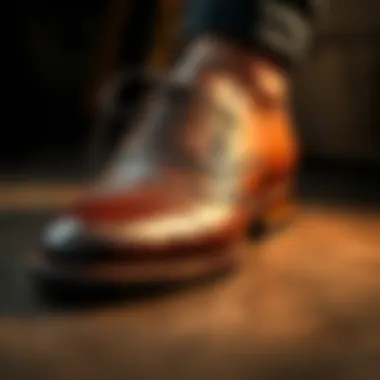
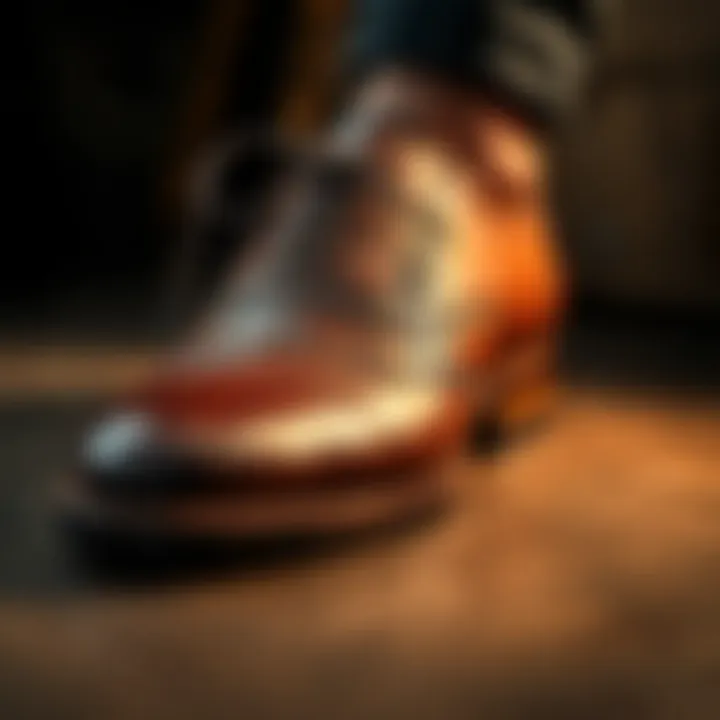
First, select your leather with care. Full-grain leather is often favored by artisans for its natural texture and strength. Once you have your material, ensure it is clean and free from any debris. You might want to dampen the leather slightly using a cloth; this can make it easier to cut and manipulate. Be mindful, though, that too much moisture can weaken the fibers.
Next, cut your leather pieces to the desired shape and size, often guided by templates. The precision of your cuts plays a role in how well the pieces will fit together. Use a sharp knife or a rotary cutter to achieve clean edges. If possible, cutting against a straight edge can also provide you with a more consistent shape.
Marking and Punching Holes
Once the leather pieces are cut, it’s time for marking and punching holes, which is an organic part of assembling your shoe. A clean, accurate hole placement is vital for a neat and functional stitch. You want to mark where the holes will be with a sharp pencil or chalk, being sure to measure twice to avoid mistakes.
To punch the holes, a sharp awl or a specialized hole punch is your best companion. Generally, holes should be spaced evenly; this not only contributes to the aesthetic of the stitch, but it also aids in even tension during sewing. Many craftsmen recommend starting from the middle of your section and working outward. This method minimizes any potential distortion that might occur while stitching.
Actual Stitching Process
Now comes the part where things really start to come together—the actual stitching process. For leather, the saddle stitch is a common method, known for its strength and durability. It involves using two needles and a single thread, weaving through the holes in opposite directions. This double-pass creates a robust bond that can withstand wear over time.
Begin by inserting one needle through the first punched hole from the outside in, then bring the second needle through the same hole from the inside out, pulling both threads taught. Continue this process, alternating between needles as you move to the next hole. Take your time; it’s better to have a well-stitched shoe than to rush and risk losing quality.
Finishing Touches
As you approach the final stages of your shoe-making journey, finishing touches can make all the difference. Trim any excess threads gently, ensuring not to cut too short. For a clean finish, you might choose to use a thread burner to seal the ends, which prevents fraying.
After that, a good leather conditioner can be beneficial to enhance the look and durability of your shoes. Apply it evenly and allow the leather to absorb. Polishing with a soft cloth adds that final sheen, elevating your handiwork to a piece of art.
Crafting a pair of hand-stitched leather shoes is a fulfilling experience that combines skill with artistry. By following these steps with attention and care, one can not only produce a product that stands the test of time but also creates a personal connection to each piece. Remember, each stitch tells a story—make yours count.
Challenges and Solutions in Hand Stitching
Hand stitching leather shoes, while profoundly rewarding, is not without its bumps in the road. Acknowledging the challenges that come along with this art can be the difference between a shoe that looks like a masterpiece and one that might as well have been thrown together in a hurry. This section aims to illuminate some common pitfalls in the hand-stitching process and the strategies to overcome them.
Common Mistakes to Avoid
Even the most seasoned craftsmen stumble occasionally. Here are some of the frequent missteps that can occur:
- Inaccurate measurements: If your patterns are off, every single piece that follows will be, as well. Always double-check your work; measure twice, cut once, as the saying goes.
- Poorly selected thread: Using the wrong type of thread can lead to seams that either don’t hold or look out of place. You’ve got to use waxed thread that suits the leather type; otherwise, your shoe can end up as frail as a wet noodle.
- Neglecting to pre-punch holes: Trying to stitch through leather without punching holes first can lead to regrets. It can ruin the leather, and believe me, no one wants to see ragged edges. It’s like trying to drive a nail into a tree without first creating a pilot hole – total chaos.
- Inconsistent stitching tension: If your stitches are too tight, you risk buckling the leather. If too loose, the integrity of the seam weakens. Finding that sweet spot takes practice but is crucial for maintaining the aesthetic that hand-stitched shoes are known for.
Becoming aware of these mistakes not only helps you avoid them but also enhances your skills over time.
Troubleshooting Stitch Tension
One of the more nuanced aspects of hand stitching is managing stitch tension. Poor tension denotes a great deal of frustration and can persist long after you’ve put the tools down. Here’s how to keep it in check:
- Inspect your setup: Always start by checking your workspace. Make sure your leather is not held too tightly while you stitch. A loose grip can cause careless stitches and a slip-up in consistency.
- Test stitches on scrap leather: Before diving into your project, use a few scraps to get a feel for how your thread reacts. This is where you can adjust the tension until it feels right, saving you from a headache when you finally work on the actual shoe.
- Monitor your hand pressure: Pay attention to how hard you pull the thread. A light tug could mean a loose stitch; a heavy pull, well, you get the idea. Practice this aspect diligently, as it can dramatically affect the outcome.
- Adjust needle size accordingly: Sometimes a simple switch of your needle can be the game changer. Using a needle that is too bulky can prevent the thread from sliding easily, leading to uneven tension. Inversely, a needle that is too small can stress the leather.
Ultimately, practice makes perfect. By recognizing these challenges and implementing solutions, you transform not just your project but also your growth as a shoemaker. Each stitch is a step forward in the journey toward mastering the art of hand-stitched leather shoes.
"Craftsmanship is not just about tools and materials; it is also about cultivating patience and honing your skills."
For further education on hand-stitching, consider visiting Wikipedia's Leathercraft and immerse yourself in the fascinating world of leatherworking.
The Aesthetic Value of Hand Stitched Shoes
Hand stitching leather shoes goes far beyond utility and functionality; it embodies an emotional connection to craftsmanship and artistry that’s hard to replicate. When one observes a pair of hand-stitched shoes, the intricate details and thoughtful designs speak volumes. Each stitch tells a story, reflecting years of skill and dedication. The aesthetic value lies in both the visual appeal and the tactile experience that only handcrafted items can offer.
This value isn't just skin deep; the aesthetics of hand-stitched shoes intricately intertwine with cultural meanings and personal expression. As consumers increasingly seek unique pieces rather than mass-produced items, the appreciation for handcrafted footwear grows. It becomes a symbol of individuality and an assertion of personal style.
Design Variations
The world of hand-stitched shoes is as varied as the artisans who create them. With different styles available, each design embodies its own unique aesthetic. Options range from classic oxfords to contemporary loafers, each providing a different vibe and function. Here are some popular design variations:
- Oxford Shoes: Timeless elegance characterized by closed lacing, making them perfect for formal settings.
- Loafers: Easy to slip on, they offer a blend of sophistication and comfort, suitable for both casual and smart attire.
- Brogues: Known for their decorative perforations, brogues combine practicality with a flair for fashion.
- Desert Boots: Casual and versatile, these boots provide a relaxed aesthetic suitable for many occasions.
Beyond these styles, there are countless variations based on the artisan’s creativity. Some may choose to experiment with hybrid designs that borrow elements from multiple styles, resulting in unique shoes that stand out simply because they are not found in typical retail outlets. Each design variation serves as a canvas for artisans to showcase their individuality as much as it reflects the wearer's personal taste.
Personalization and Customization
Hand-stitched leather shoes offer an unmatched opportunity for personalization. Unlike machine-made footwear, where options may be limited, artisans welcome requests for custom touches that make each pair distinctly yours. Personalization can be a subtle or bold choice, depending on your preferences.
Several ways to add a personal touch include:
- Monograms: Adding initials can make the shoes uniquely yours and provide an air of sophistication.
- Color Choices: Selecting different shades, from classic blacks and browns to vibrant hues, allows the wearer to express their personality.
- Customized Soles: Different soles can not only impact the aesthetic but also improve comfort, especially for those who value function as much as form.
- Special Stitching Patterns: Personal choices in stitching styles and colors create a unique look that can differentiate your shoes from the rest of the crowd.
In essence, the capacity for personalization elevates these shoes to more than mere accessories—they become a personal statement. It invites the wearer to participate in the art of creation, making them part of the journey behind the craftsmanship.
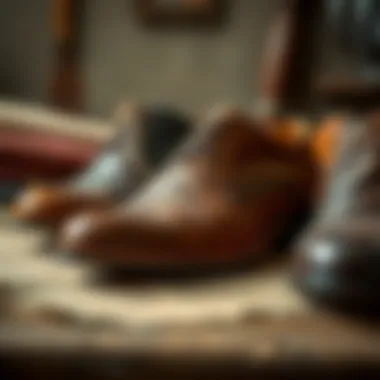
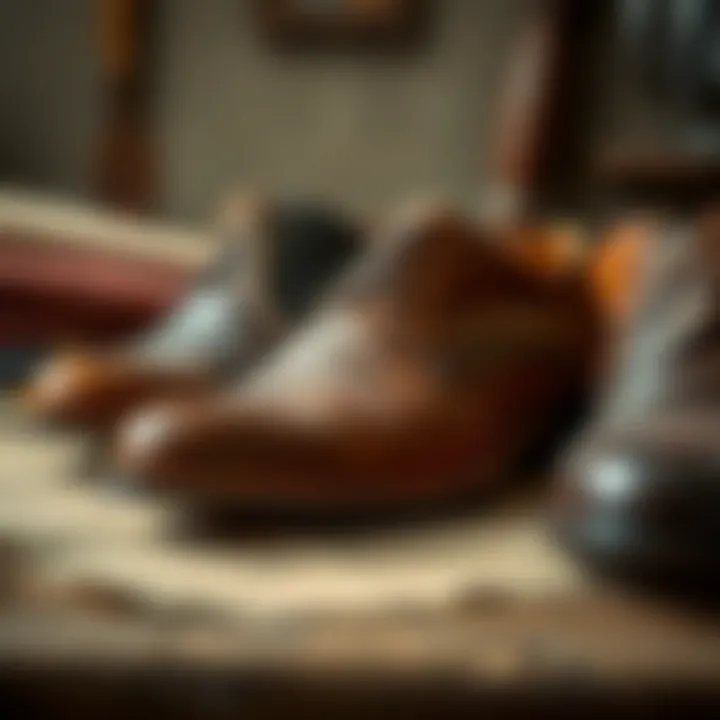
“The beauty of hand-stitched leather shoes lies not only in their design but also in the stories and emotions stitched into each pair.”
As we look at the aesthetic value of hand-stitched leather shoes, it is essential to recognize how they serve as a focal point for details that marry art with functionality. The design variations provide countless avenues for expression, while personalization transforms a simple pair of shoes into a work of art that resonates with the wearer on a profound level.
Comparison with Machine-Made Shoes
The discussion around the craft of hand stitching leather shoes inevitably invites a comparison with machine-made footwear. This juxtaposition serves not only to highlight the unique characteristics of hand-stitched shoes but also to underline their significant cultural and economic implications in today’s fashion landscape.
Quality and Durability
Hand-stitched leather shoes are often revered for their superior quality and durability when stacked against their machine-made counterparts.
- Craftsmanship: Each pair of hand-stitched shoes is a product of meticulous craftsmanship. The artisans dedicate considerable time to ensure every stitch is anchored to perfection. This is not just about aesthetics; it also means a more durable product. Hand stitching, particularly techniques like the saddle stitch, reinforces the seams effectively. This allows the shoes to withstand wear and tear far better than machine-stitched versions, which may yield to stress under rigorous use.
- Material Selection: Many shoemakers focus on high-quality, traditional materials, such as full-grain leather. The natural imperfections in this kind of leather create a character unique to each shoe, enhancing both visual appeal and longevity. Machine-made shoes, in contrast, often utilize synthetic materials or lower-grade leather, which can lead to faster wear and tear.
"While machine-made shoes might be easier and quicker to produce, they rarely capture the essence of individuality found in hand-stitched pieces."
- Repairability: Another key factor lies in the reparability of hand-stitched shoes. When damage occurs, a skilled cobbler can often repair them, re-stitching or replacing components. This not only extends the lifespan of the footwear but also nurtures a sustainable fashion ethos—one that emphasizes quality over quantity. Machine-made shoes, with their systematic construction, frequently lack this reparative potential and often end up as waste after a season.
Cost Implications
When it comes to costs, the price for hand-stitched leather shoes can indeed elevate eyebrows, especially compared to their mass-produced equivalents. However, a deeper look reveals that the price tag is a reflection of various factors, rather than mere markup.
- Investment Worth: Purchasing hand-stitched shoes should be viewed as an investment. The initial expenditure may be higher, but if one considers the longevity and comfort of a quality pair, the long-term financial implications often favor the hand-crafted option. Investing in a pair of shoes that can last decades, rather than mere seasons, represents a more economical choice in the grand scheme.
- Artisan Value: Furthermore, the artisanship involved in crafting hand-stitched shoes commands a value that machine-made shoes simply cannot match. Each shoe embodies the skill and labor invested in its creation, making them not just products, but wearable art. This artisanal quality contributes to their higher prices but similarly enhances their appeal among sophisticated consumers who appreciate craftsmanship.
- Market Demand: There’s also a rising demand for sustainable products in the fashion arena. As more consumers become eco-conscious, they look for alternatives to fast fashion that resonate with their values. This shift has repercussions on pricing as well: hand-stitched shoes may see rising costs due to increased demand and the attention to detail they require to produce.
Caring for Hand Stitched Leather Shoes
Taking proper care of hand-stitched leather shoes is essential for preserving their beauty, functionality, and longevity. Unlike their machine-made counterparts, hand-stitched shoes are crafted with intricate techniques, making them more sensitive to wear and tear. Understanding how to maintain these shoes elevates their overall quality and extends their lifecycle. Given the investment in hand-stitched footwear, neglecting their care can lead to irreversible damage. Therefore, this section provides practical tips and considerations that will ensure your cherished shoes remain in top condition for years to come.
Cleaning and Maintenance Tips
Regular cleaning is one of the cornerstones of shoef care. Dust and dirt can accumulate on the leather, leading to degradation over time. Here are several practical steps for maintaining your hand-stitched leather shoes:
- Dust Daily: Use a soft cloth or a horsehair brush to gently remove dust after each wear. This stops grime from embedding into the leather.
- Spot Clean: For stains, opt for a damp cloth with a mild soap solution. Avoid harsh chemicals that may strip away the leather’s natural oils.
- Condition Regularly: Leather benefits from conditioning. A good leather conditioner will restore moisture that can be lost over time. Look for a product that is free from silicone, as it might harm the leather’s finish.
- Polish Sparingly: When polishing, choose a quality wax that matches the color of your shoes. A little goes a long way; just apply a thin layer and buff gently.
- Waterproofing: Consider applying a water-repellent spray specifically designed for leather. This acts as a barrier against moisture, but always test on a small area first to ensure compatibility.
"Leather is a living material, and like all living things, it needs care and attention to thrive."
Storage Recommendations
Proper storage is equally significant in maintaining the integrity of hand-stitched leather shoes. If not stored correctly, the shoes can lose their shape or encounter unwanted damage. Here are key considerations for storing your footwear:
- Use Shoe Trees: Inserting wooden shoe trees helps absorb moisture and maintain the shape of the shoes. Choose ones that fit well but do not stretch the leather.
- Keep in a Cool, Dry Place: Avoid placing them in direct sunlight or near heat sources to prevent warping and fading.
- Avoid Plastic Bags: Instead, opt for dust bags made of breathable fabric to protect your shoes from dust while allowing airflow.
- Stack Carefully: If you own multiple pairs, avoid stacking them on top of each other. This could cause creasing and deformations in the leather.
- Rotate Your Shoes: Give your shoes a day off between wears. This reduces stress on the leather and allows them to recover.
In summary, caring for hand-stitched leather shoes requires a thoughtful approach to cleaning and storage. By embracing the intricacies of maintenance, you can uphold the craftsmanship and beauty of each pair, ensuring they remain a staple in your footwear collection.
The Future of Hand Stitching in Fashion
Sustainability Considerations
Sustainability has become a cornerstone in contemporary fashion discourse. The push for eco-friendly practices has gained traction, with many designers seeking methods that respect both people and the planet. Hand stitching inherently supports sustainability in several ways:
- Durability: Shoes crafted through hand-stitching often showcase superior durability compared to their machine-made counterparts, leading to a longer lifespan for footwear. This longevity helps reduce waste in the fashion cycle, as fewer shoes end up in landfills.
- Ethical Sourcing: Artisans who produce hand-stitched shoes often have the capability to choose materials sourced from sustainable farms or leather tanneries, promoting ethical practices within the industry.
- Lower Carbon Footprint: The processes involved in hand stitching typically require less energy and fewer resources than machines. As a result, each pair represents a more sustainable choice.
Emphasizing hand stitching may appeal to eco-conscious consumers who are increasingly making purchasing decisions based on a brand's commitment to green practices. The rise of slow fashion—favoring quality over quantity—speaks volumes about how the craft of hand-stitched footwear can thrive in a world searching for sustainable alternatives.
Revival of Traditional Techniques
Amidst the digital age, a noticeable counter-movement has emerged, advocating for the revival of traditional craftsmanship. The emotional connection that comes from creating something by hand resonates deeply in a world dominated by mass production. Hand stitching encapsulates this nostalgia; every stitch reflects the individuality of its maker. Here are a few factors fueling the revival:
- Cultural Heritage: Many traditional methods, passed down from generation to generation, carry the stories of their origins. By embracing these techniques, artisans honor their heritage while introducing these timeless skills to a new audience.
- Customization: Today's consumer craves uniqueness, prompting a shift away from generic options. Hand-stitched shoes offer personalization, allowing clients to select specific leathers, colors, and designs, making each pair a bespoke experience. This kind of interaction between the artisan and the customer fosters a deeper bond.
- Quality Over Quantity: As fast fashion continues to draw criticism, brands that focus on meticulously crafted shoes stand to gain favor. Customers are becoming discerning, leaning towards investments in quality footwear designed to stand the test of time, and hand-stitched shoes fit this bill beautifully.
Epilogue
Hand-stitched shoes encapsulate individuality. Each pair tells a story, whether it be the choice of leather or the unique stitching pattern. Many consumers today gravitate towards items that offer a personal touch, and hand-stitched footwear certainly delivers in that regard. Not only do they offer better fit and comfort, but they also surpass mass-produced options in terms of durability and quality. The investment in such shoes is an investment in sustainability, as they tend to last longer with proper care, thereby reducing waste.
Final Thoughts on Craftsmanship
Investing time and skill into the craft of hand stitching fosters a deeper appreciation for what is often overlooked in today’s fast-paced world. This craftsmanship is grounded in age-old techniques that remain relevant even in current fashion trends. A shoemaker’s dedication to detail — from selecting the right leather to the final polish — ensures that every shoe is functional yet refined.
"Craftsmanship isn't just a skill; it's an art that requires time, dedication, and a genuine passion for creating something special."
For fashion designers, stylists, and retailers, understanding the nuances of hand-stitched leather shoes can inform more sustainable and ethical business practices. Viewing shoes not merely as commodities, but as artisanal products crafted with care, can shift consumer perspectives significantly.
Whether you are stepping into this craft as a novice or are well-versed in leatherwork, the spirit of hand stitching invites you to create with intent and purpose. It's about maintaining a balance between tradition and evolution, ensuring that craftsmanship remains not just a method but a philosophy in the world of fashion.
For those interested in learning more about this noble art, resources such as Wikipedia or the Museum of Leathercraft and Design can provide further insight into the historical and cultural aspects of shoemaking. Websites like reddit.com offer forums for enthusiasts to share tips and techniques, fostering a sense of community around this esteemed craft.
In sum, the journey into hand stitching leather shoes culminates in a profound respect for artistry and heritage, making it an enriching endeavor for both the maker and the wearer.



